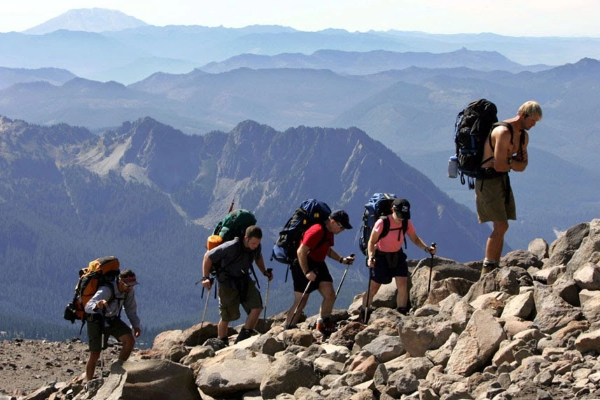When people think about exploring the great outdoors, two activities often come to mind: hiking and mountain climbing. While both offer an opportunity to connect with nature and challenge oneself, they are fundamentally different in terms of activity level, required equipment, safety considerations, terrain, and the experience they offer.
Understanding these differences is essential for anyone looking to choose between the two activities or explore both safely and effectively.
SEE ASLO: What Gear Do I Need for Downhill Mountain Biking
Activity Level & Difficulty
Hiking: Hiking generally involves walking on established trails, which can range from easy strolls in a local park to more challenging ascents up mountain paths. The difficulty of hiking varies widely, making it accessible to a broad audience. Beginners can enjoy flat, well-marked trails that provide a leisurely experience, while seasoned hikers might seek out more strenuous routes with steep inclines and rough terrain. The common denominator in hiking is that it’s usually a non-technical activity, meaning no special skills or training are required beyond basic fitness.
Mountain Climbing: Mountain climbing, on the other hand, is a physically demanding activity that often involves technical climbing skills, such as scaling rock faces, traversing glaciers, or ascending steep ice walls. Unlike hiking, mountain climbing usually takes place at higher altitudes where the air is thinner, increasing the physical strain on the body. Climbers must be in excellent physical condition and possess the technical knowledge necessary to navigate these challenging environments. The difficulty of mountain climbing is significantly higher than most hikes, and it’s not uncommon for climbers to spend years training and preparing for a single ascent.
Equipment & Preparation
Hiking: The equipment needed for hiking is relatively basic. Essential gear includes sturdy hiking boots, comfortable clothing suitable for the weather, a backpack, and plenty of water. Depending on the trail and conditions, hikers might also carry trekking poles, a map, and a compass. In general, the gear required for hiking is designed for comfort and convenience, rather than for technical performance.
Mountain Climbing: Mountain climbing demands specialized gear that is both technical and essential for safety. Climbers use ropes, harnesses, carabiners, ice axes, crampons, helmets, and protective clothing designed to withstand harsh conditions. In addition to physical gear, climbers need extensive preparation, including training in climbing techniques, rope handling, and rescue procedures. Unlike hiking, where preparation might involve checking the weather and packing a lunch, mountain climbing preparation is an ongoing process that includes physical training, skill development, and mental conditioning.
Safety Considerations
Hiking: While hiking is generally safe, there are still risks to be aware of. Potential hazards include encounters with wildlife, sudden changes in weather, and challenging trail conditions, such as loose rocks or steep descents. Basic first aid knowledge is advisable, and hikers should always be prepared for the unexpected by carrying a first aid kit, extra layers of clothing, and enough food and water for the journey. It’s also important to inform someone of your plans and expected return time, especially when hiking in remote areas.
Mountain Climbing: The safety risks associated with mountain climbing are significantly higher due to the technical nature of the activity and the environments in which it takes place. Climbers face dangers such as falls, avalanches, rockslides, and exposure to extreme weather conditions, including high winds and sub-zero temperatures. The risk of altitude sickness is also a major concern, particularly at elevations above 8,000 feet (2,400 meters). To mitigate these risks, climbers must adhere to strict safety protocols, which include conducting thorough route planning, using proper gear, and climbing with experienced partners. Knowledge of rescue techniques and emergency procedures is crucial, as help may be hours or even days away.
Terrain & Environment
Hiking: Hiking typically takes place on well-established trails that wind through various landscapes, including forests, meadows, and mountain paths. While some hikes may involve rocky terrain or steep climbs, they generally do not require technical climbing skills. The environment on a hiking trail is often predictable and marked, making it easier for hikers to navigate. The focus is on enjoying the scenery, spotting wildlife, and reaching a scenic viewpoint or summit.
Mountain Climbing: The terrain encountered in mountain climbing is far more rugged and varied. Climbers may need to navigate sheer rock faces, icy slopes, and glaciers, often with no established path to follow. This type of environment requires a high level of skill and experience to manage the challenges presented by unstable surfaces, rapidly changing weather, and the physical demands of climbing at altitude. The unpredictability of the terrain and conditions adds to the complexity and risk of the activity, making mountain climbing a pursuit for those seeking a true adventure.
Conclusion
In summary, the differences between hiking and mountain climbing are substantial, with each activity offering a unique experience. Hiking is accessible to a wide range of individuals, providing an opportunity to enjoy nature at a comfortable pace with minimal risk. Mountain climbing, on the other hand, is a more demanding and technical pursuit, requiring extensive preparation, specialized equipment, and a higher tolerance for risk.
When choosing between hiking and mountain climbing, it’s important to consider your own experience level, physical fitness, goals, and risk tolerance. For those new to outdoor activities, hiking is an excellent starting point that offers both enjoyment and physical benefits. Mountain climbing, however, is best suited for those with the necessary skills and experience, looking to challenge themselves in a more extreme environment.

